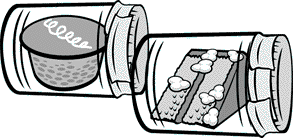|

What is mold, anyway?
That fuzzy stuff growing on the food in your
mold terrarium is mold, a kind of fungus. Mushrooms are one kind
of fungus; molds are another.
Unlike plants, molds don't grow from seeds.
They grow from tiny spores that float around in the air. When
some of these spores fall onto a piece of damp food, they grow
into mold.
Green plants are green because they contain a
chemical compound called chlorophyll. Chlorophyll makes it
possible for green plants to capture the energy of sunlight and
use it to make food (sugars and starches) from air and water.
Unlike green plants, mold and other fungi have no chlorophyll
and can't make their own food. The mold that grows in your mold
terrarium feeds on the bread, cheese, and other foods. The mold
feeds itself by producing chemicals that make the food break
down and start to rot. As the bread rots, the mold grows.
Ick! Who wants this stuff around?
It can be annoying to find moldy food in your
refrigerator. But in nature, mold is a very useful thing. Mold
helps food rot, which is an icky but necessary thing. In a
natural environment, rotting things return to the soil,
providing nutrients for other plants. Mold is a natural
recycler.
Why does the mold on different foods look
different?
There are thousands of different kinds of
molds. One mold that grows on lemons looks like a blue-green
powder. A mold that grows on strawberries is a grayish-white
fuzz. A common mold that grows on bread looks like white cottony
fuzz at first. If you watch that mold for a few days, it will
turn black. The tiny black dots are its spores, which can grow
to produce more mold.
 Why
didn't some foods get moldy? Why
didn't some foods get moldy?
If you used foods that contain preservatives,
mold may not have grown very well on them. If you want to
experiment more with mold, you can make one mold terrarium using
food with preservatives (like a packaged cupcake) and another
using food that doesn't have preservatives (like a slice of
homemade cake). Which one grows more mold? You can also
experiment with natural preservatives like vinegar and salt. If
you do more experimenting, let us know what you discover!
|